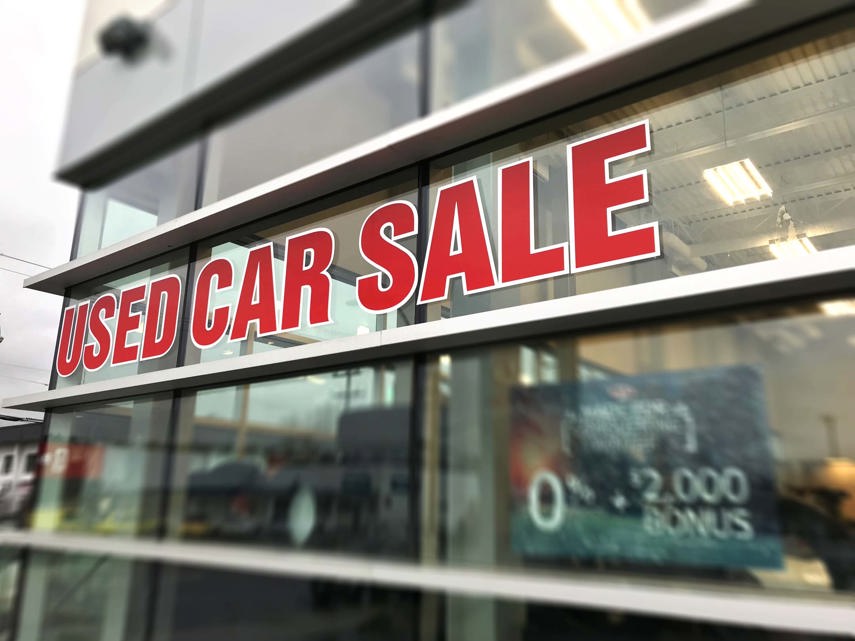Buying your first vehicle is a huge undertaking that can be a bit overwhelming and create some anxiety as you try to do everything right. We have 12 tips for first-time car buyers to follow that should help to make the process easier.

Should You Buy a New or Used Car?
Both new and used vehicles have strong pros and cons. A new vehicle is convenient – you just pick one or place your order at the dealer, and you can get the features or options you want. It has a factory warranty and it may also be easier for you to get financing on a new vehicle over a used one. Some people like buying new cars for the peace of mind or even that “new car smell.”
A used vehicle will be less expensive than a comparable new one because someone else has already taken the hit for depreciation, and it will likely cost less to insure. However, you have to shop around for one, you might not get all the features you want, and if you’re buying it privately, you should have a trusted mechanic look it over before you buy. Certified pre-owned vehicles typically are fully inspected and repaired up to manufacturer standards and even come with warranties, combining the best of both worlds.
Don’t Buy More Car Than You Actually Need
Generally, a bigger vehicle will cost more, use more fuel, and be harder to park in tight spots. Will you regularly carry enough people in an SUV to need three rows instead of two? Will you tow or haul enough to need a full-size truck – or are you better off buying a smaller one, and paying for delivery when you occasionally buy something larger than it can carry? Be honest with yourself about what you’ll be using your car for on most days and buy based on that instead of on what you might use it for on rare occasions. Being realistic about your needs versus your wants can ultimately save you cash.

Research the Vehicles You’re Considering
Automaker, dealer websites, and AutoTrader’s own Vehicle Research Pages will give you all the information you need, including each vehicle’s trim levels, features and specifications, and the MSRP (manufacturer’s suggested retail price). Some of these sites even have the ability to compare different models. Beyond that, look at such online resources as expert reviews and videos, reliability surveys, and even used-car reviews, to see how well each model performs as it ages. The more you research, the more confident you’ll be.
Be wary of websites that, for free or a small charge, will give you a vehicle’s “invoice cost” – what your local dealer paid the automaker for the car, with the claim it’ll help you negotiate. But that price is seldom accurate, and it’s almost guaranteed the site is selling your contact information to the dealership.
Think About Features and Options You Need vs. What Is “Nice to Have”
You don’t necessarily need to go bare-bones, but consider what each feature costs – and, in some cases, what it will cost in future to repair or maintain. Larger wheels look good, but replacements or winter tires will be more expensive. A more powerful engine will use more fuel, and a diesel engine will have costly oil changes. A heated windshield is amazing in the winter, but they’re also very costly to replace.
Still, not all features are needless extras, especially if you’re considering the car’s future resale value. Features like heated seats, wireless phone connectivity, or a sunroof may increase your resale value down the road. A manual transmission may be a resale bonus on a performance car, but not on an everyday commuter car, where most buyers for your used vehicle will prefer an automatic.

Ask Friends and Family for Recommendations
Ask people you trust what they like about their vehicles and, even more importantly, what they don’t like about their cars. Something that’s annoying from the start seldom gets better with time. Ask which dealers and salespeople they like and trust, and get them to introduce you – as well as steer you away from any they’ve learned to avoid.
Do a Thorough Test Drive
You don’t get to know a vehicle by just taking it around the block. In addition to urban streets, get on the highway to test its power for merging and passing. Turn it tightly to check the turning circle, and park it, both nose-in and backing in. Try driving it during the day but also when it’s dark outside. Check that you have a comfortable seating position, with good visibility all around, and without the seatbelt cutting into your neck. If you can’t do that with a manual seat, you may have to option a power-adjustable one.
If you regularly carry larger items – your golf clubs or dog crate, for example – bring them along to see if they fit. Is it easy to install a child seat? Is there a place for your bag, your phone, your coffee mug? Are the controls easy to operate without distraction, and can you pair your phone? Will the car fit in your garage? You don’t want to discover issues after you’ve bought the vehicle.

Know Your Credit Score
Find out what you can borrow and use this to set your car-buying budget. Before you head to the dealership, consider applying for a pre-approved loan at your bank. You can compare its rates and payments to the dealer’s financing, and then use the most favourable of the two.
Long-Term Loans Are a Bad Idea
Some car loans can span 84 to 96 months – and that’s seven to eight years. The payments are lower, but they come with all sorts of issues.
You’ll spend more money on interest and finance charges on a longer loan. You may also be tempted to overspend – you might not add a $1,000 option out of your pocket, but if it’s only $10 a month, it seems easier to swallow. You’ll also be “underwater” longer – when you owe more money on the car than it’s actually worth. As the vehicle depreciates, a crash could potentially write it off – but you’ll still owe years of payments on a vehicle that you no longer own.
Some automakers and dealers advertise ultra-low semi-monthly or even weekly payments. Ignore them. Instead, look at the vehicle’s total cost, including taxes, fees, and finance charges, and set your budget from there.

Look for Discounts and Rebates
Some vehicles have factory or dealer discounts, incentives, or rebates, especially if they’re not the hottest new models. Some automakers offer specialized rebates, such as discounts for recent university graduates, healthcare workers, or if you need mobility adaptations such as hand controls. These aren’t always prominently advertised, so be sure to ask.
Sometimes you’ll be given a choice of discounts, such as low- or zero-per cent financing or a cash bonus. Compare them carefully and determine which one will ultimately save you more money.
What Fees Can You Negotiate?
Vehicles come with numerous extra charges. You can haggle on some, while others are non-negotiable. You will have to pay the sales taxes, “green” fees such as air conditioning tax and tire stewardship fees, and freight/destination. Your province may impose a mandatory fee, usually no more than $10, for its auto industry regulation councils, such as OMVIC in Ontario, or AMVIC in Alberta.
You may be able to negotiate or eliminate some of the other fees. These include dealer administration charges for writing up the paperwork, or getting the vehicle’s licence plates (you have to pay for the plates themselves, of course); anti-theft add-ons, such as etching the VIN (vehicle information number) into the windows; activating features like satellite radio; filling the tires with nitrogen instead of plain air; or fuel in the tank.
Before you sign anything, have the salesperson explain every fee. Once you’ve agreed to the full price, sign and date the invoice, and get a copy of it.
Understand the Warranties
Every new car has a factory warranty. You may then be offered an extra-charge extended warranty. It’s not required, and your factory warranty won’t be affected if you don’t buy it. But if you are considering one, be very cautious. Get in writing exactly what it does and doesn’t cover, and if there’s a deductible. Make sure it starts after the factory warranty expires. Otherwise, you’re paying for extra warranty on top of coverage you already have.
If you do buy one, we recommend plans sold by the automaker. Third-party warranties may be less expensive, but they’re restrictive. You may have to wait for the warranty company to authorize your repair, and possibly have to pay up front and wait to be reimbursed for it.
Understand and Consider the Cost of Ownership
Your car will continue to tug at your wallet after you’ve bought it, so take those expenses into account when you’re choosing a vehicle. A pricier car will cost more to insure and an engine that requires premium-grade fuel will cost more at the pump.
Wear items, such as brakes, are usually pricier on luxury or performance vehicles. A less-expensive vehicle will have lower car payments and generally cost you less to maintain. Buying within your budget is always best with any vehicle purchase, and especially with your first. Happy shopping!


